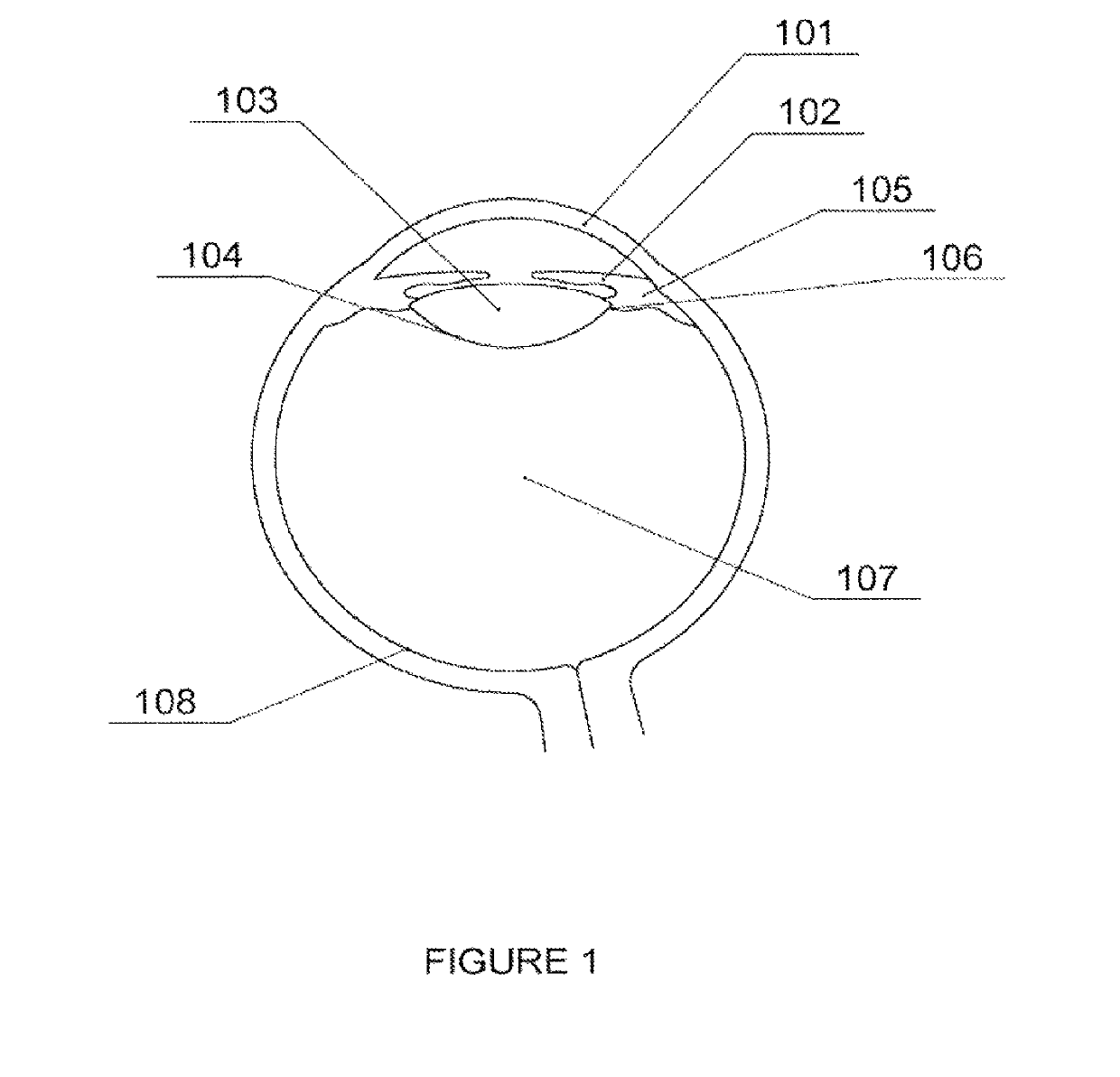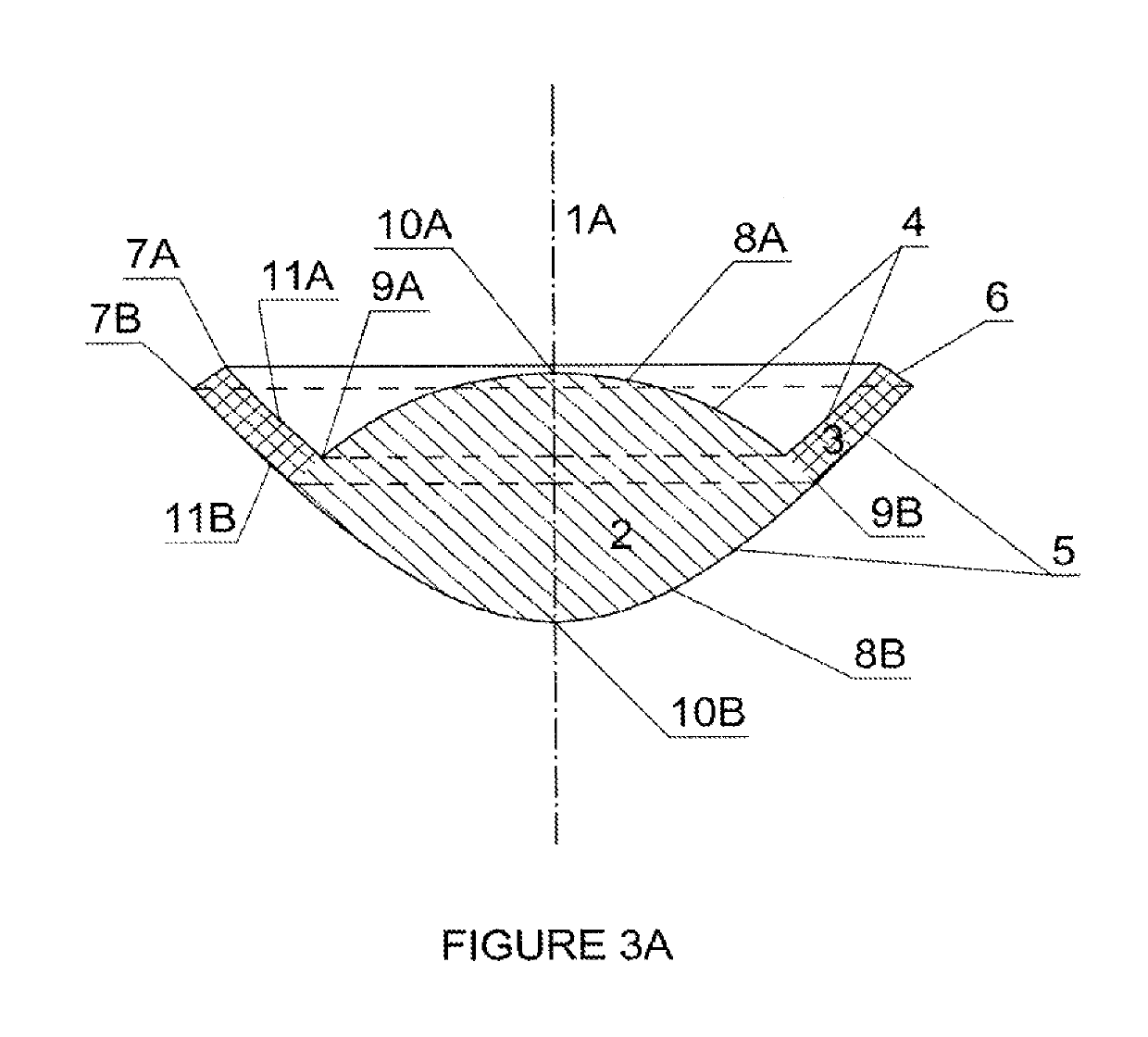Light-adjustable hydrogel and bioanalogic intraocular lens
a bioanalytical, hydrogel technology, applied in the field of hydrogel implantable ophthalmic lenses, can solve the problem that hyperbolic aberration cannot be achieved for either a convex or concave meniscoid surface, and achieve the effect of reducing the risk of ocular ocular ocular ocular ocular ocular ocular ocular ocular ocular ocular ocular ocular ocular ocular
- Summary
- Abstract
- Description
- Claims
- Application Information
AI Technical Summary
Problems solved by technology
Method used
Image
Examples
example 1
[0198]The following monomer mixture was prepared: 98 weight parts of 2-hydroxyethyl methacrylate (HEMA), 0.5 wt % of triethyleneglycol dimethacrylate (TEGDMA), 1 wt % of methacryloyloxybenzophenone (MOBP), 1 wt % of methacrylic acid, 0.25 wt % of camphorcquinone (CQ) and 0.05 wt % of trieathanolamine (TEA). The mixture was de-aired using by carbon dioxide and filled into two-part plastic molds shown schematically in FIG. 8 where 18B is the part of the mold for molding the a posterior lens surface, 18A is the part of the mold to shape the anterior part of the surface of the lens. Both parts are injection molded from polypropylene (PP). The shaping surface 19B of the part 18B has shape formed by two concentric hyperboloids. The central part of the surface has the diameter 3 mm, central radius of 3.25 mm and conic constant −3.76 while the peripheral is hyperboloid with central radius of 3.25 mm and conic constant −6.26. The molding surface is equipped with a protruding circular barrier...
example 2
[0202]The following monomer mixture was prepared: 94 weight parts of 2-hydroxyethyl methacrylate (HEMA), 0.5 wt % of triethyleneglycol dimethacrylate (TEGDMA), 4.5 wt % of methacryloyloxybenzophenone (MOBP), 1 wt % of methacrylic acid and 0.25 wt % of dibenzoylperoxide. The mixture was de-aired using nitrogen carbon and filled into two-part plastic molds shown schematically in FIG. 8. The shaping surface 19B of the part 18B has a shape formed by two concentric surfaces. The central part of the surface has the diameter 3 mm, central radius of 3.00 mm and conic constant 1 while the peripheral section is a hyperboloid with central radius of 3.25 mm and conic constant −6.26. The molding surface is equipped with a protruding circular barrier 20 on diameter 8.8 mm that has asymmetric triangular profile, height 0.15 mm. The inner side of the barrier 20 is designed to shape the connecting surface 6 in FIG. 3A.
[0203]The part 18A has the shaping surface 19A that is divided into the central pa...
example 3
[0206]The following monomer mixture was prepared: 94.5 weight parts of 2-hydroxyethyl methacrylate (HEMA), 0.5 wt % of triethyleneglycol dimethacrylate (TEGDMA), 5 wt % of methacryloyloxybenzophenone (MOBP) and 0.25 wt % of dibenzoylperoxide. The mixture was de-aired using nitrogen carbon and filled into two-part plastic molds shown schematically in FIG. 8. The shaping surface 19B of the part 18B has a shape formed by two concentric surfaces. The central part of the surface has the diameter 6.5 mm, central radius of 4.5 mm and conic constant 0 while the peripheral section is a hyperboloid with central radius of 4.25 mm and conic constant −8. The molding surface is equipped with a protruding circular barrier 20 on diameter 9.3 mm that has asymmetric triangular profile, height 0.35 mm. The inner side of the barrier 20 is designed to shape the connecting surface 6 in FIG. 3A.
[0207]The part 18A has the shaping surface 19A that is divided into the central part 21 of diameter 6.4 mm and t...
PUM
| Property | Measurement | Unit |
|---|---|---|
| water content | aaaaa | aaaaa |
| water content | aaaaa | aaaaa |
| wavelength | aaaaa | aaaaa |
Abstract
Description
Claims
Application Information
 Login to view more
Login to view more - R&D Engineer
- R&D Manager
- IP Professional
- Industry Leading Data Capabilities
- Powerful AI technology
- Patent DNA Extraction
Browse by: Latest US Patents, China's latest patents, Technical Efficacy Thesaurus, Application Domain, Technology Topic.
© 2024 PatSnap. All rights reserved.Legal|Privacy policy|Modern Slavery Act Transparency Statement|Sitemap



